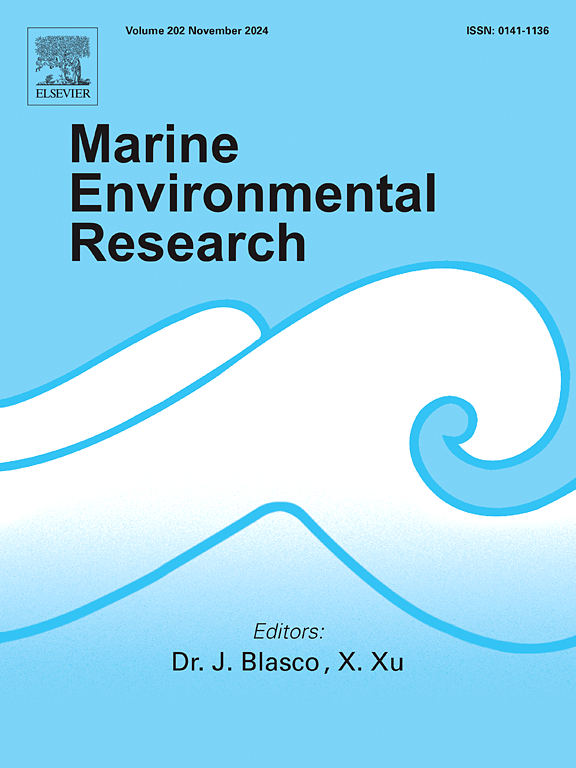气候变化对东热带太平洋榄蠵龟适宜生境的影响
IF 3
3区 环境科学与生态学
Q2 ENVIRONMENTAL SCIENCES
引用次数: 0
摘要
榄蠵龟(Lepidochelys olivacea)是世界上最丰富的海龟物种之一,但其种群数量受到包括气候变化在内的各种环境变化的威胁。了解海洋环境如何影响它对保护工作至关重要。本研究模拟了热带东太平洋地区橄榄松鸡(L. olivacea)的生境适宜性,该地区对橄榄松鸡的筑巢和觅食活动具有重要的生态意义。我们使用了2009年至2018年间在巴拿马和哥斯达黎加标记的59个人的遥感数据。利用MaxEnt模型,利用仅存在的方法和环境变量,包括海面温度、海洋混合层厚度、叶绿素-a浓度和洋流速度,对响应进行建模。我们将月份分为温暖(El Niño)和寒冷(La Niña)两类,从而深入了解气候变化的影响。结果表明,叶绿素-a浓度和海温最能预测橄榄藻的存在。热带辐合带表现出较高的生境适宜性,特别是在中太平洋地区。在El Niño期间,适合的栖息地减少,主要沿着海岸线,而在La Niña期间,它扩大,有利于海洋水域和上升流区的温带温度。这些发现表明,气候变化可能会显著影响L. olivacea的分布,可能会改变筑巢和觅食区域。本文章由计算机程序翻译,如有差异,请以英文原文为准。
Climate change implications in the suitable habitat of olive ridley turtle Lepidochelys olivacea in the Eastern Tropical Pacific
The olive ridley turtle Lepidochelys olivacea is one of the most abundant marine turtle species, but its populations are threatened by various environmental changes, including climate change. Understanding how the marine environment influences it is crucial for conservation efforts. This study models the habitat suitability of L. olivacea in the Eastern Tropical Pacific, a region of significant ecological importance for its nesting and foraging activities. We used remote sensing data from 59 individuals tagged in Panama and Costa Rica between 2009 and 2018. The response was modeled with MaxEnt, using a presence-only approach and environmental variables including sea surface temperature, ocean mixed layer thickness, chlorophyll-a concentration, and current velocity. We categorized months into warm (El Niño) and cold (La Niña) conditions, providing insight into climate change effects. Results reveal that chlorophyll-a concentration and sea surface temperature best predicted the presence of L. olivacea. The intertropical convergence zone exhibited high habitat suitability, especially in the Central Pacific. During El Niño, suitable habitat declined, primarily along coastlines, while, during La Niña, it expanded, favoring oceanic waters and temperate temperatures in upwelling zones. These findings suggest climate change could significantly impact L. olivacea distribution, potentially shifting nesting and foraging areas.
求助全文
通过发布文献求助,成功后即可免费获取论文全文。
去求助
来源期刊

Marine environmental research
环境科学-毒理学
CiteScore
5.90
自引率
3.00%
发文量
217
审稿时长
46 days
期刊介绍:
Marine Environmental Research publishes original research papers on chemical, physical, and biological interactions in the oceans and coastal waters. The journal serves as a forum for new information on biology, chemistry, and toxicology and syntheses that advance understanding of marine environmental processes.
Submission of multidisciplinary studies is encouraged. Studies that utilize experimental approaches to clarify the roles of anthropogenic and natural causes of changes in marine ecosystems are especially welcome, as are those studies that represent new developments of a theoretical or conceptual aspect of marine science. All papers published in this journal are reviewed by qualified peers prior to acceptance and publication. Examples of topics considered to be appropriate for the journal include, but are not limited to, the following:
– The extent, persistence, and consequences of change and the recovery from such change in natural marine systems
– The biochemical, physiological, and ecological consequences of contaminants to marine organisms and ecosystems
– The biogeochemistry of naturally occurring and anthropogenic substances
– Models that describe and predict the above processes
– Monitoring studies, to the extent that their results provide new information on functional processes
– Methodological papers describing improved quantitative techniques for the marine sciences.
 求助内容:
求助内容: 应助结果提醒方式:
应助结果提醒方式:


